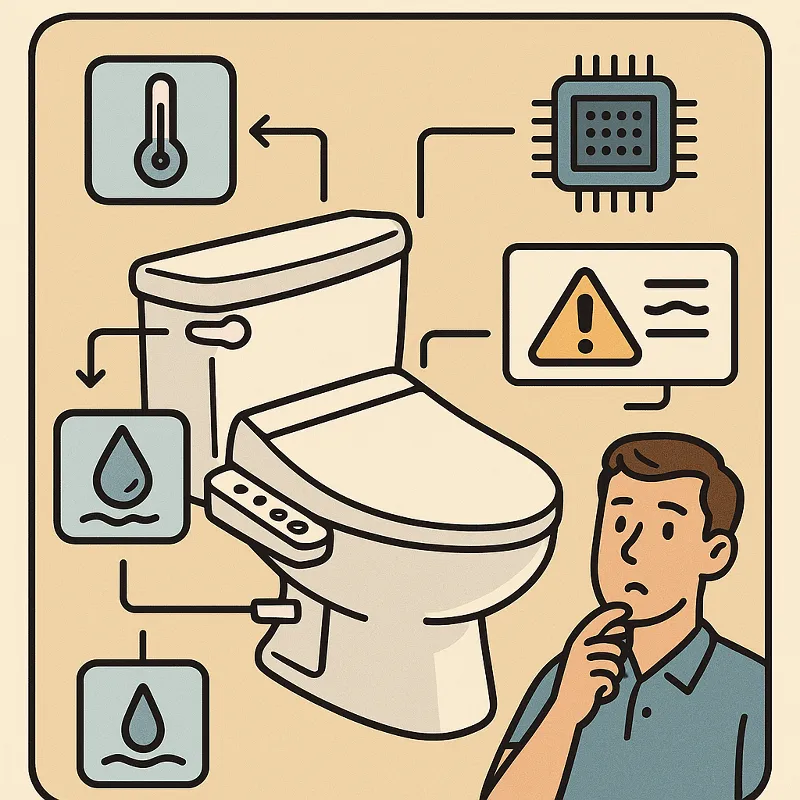
Understanding Bidet Self-Diagnosis
Bidets have become an increasingly popular bathroom fixture in many households, known for their hygiene benefits and efficiency. Modern bidets come equipped with advanced technology, including self-diagnosis functions, which help maintain performance and troubleshoot issues. Understanding these self-diagnosis principles is essential for users to get the most out of their bidet systems. In this article, we delve into the technicalities of bidet self-diagnosis functions, explaining how they work and why they are beneficial.
Latest Bidet Trends: Analyzing AI-Equipped Models 👆Components of Self-Diagnosis
The self-diagnosis function in a bidet relies on several key components working in harmony. Primarily, these include sensors, microcontrollers, and software algorithms that monitor and analyze the bidet’s operational status. Sensors are strategically placed to detect issues such as leaks, clogs, or electrical faults. The microcontroller acts as the brain, interpreting signals from the sensors and executing the necessary diagnostics. Software algorithms are designed to pinpoint anomalies, providing feedback to the user through indicators or digital displays. Together, these components create a robust system that preemptively addresses potential problems, ensuring smooth and efficient operation.
Analysis of Evolving Trends in Bidet Marketing 👆How Sensors Work
Types of Sensors
Various sensors are embedded within bidet systems to facilitate self-diagnosis. Common types include pressure sensors, temperature sensors, and moisture sensors. Pressure sensors monitor water flow and detect any abnormalities in water pressure that might indicate a blockage or leak. Temperature sensors ensure the water is heated to the desired level, while moisture sensors check for leaks or excess condensation within the unit. Each sensor serves a specific function, contributing to a comprehensive diagnostic process that keeps the bidet functioning optimally.
Sensor Placement
The placement of sensors is crucial to effective self-diagnosis. Sensors must be strategically located to accurately capture the necessary data without interference. For instance, pressure sensors are often installed near water inlets, while temperature sensors are located close to heating elements. Moisture sensors are typically placed in areas prone to leaks, such as under the bidet seat or near connections. Proper sensor placement ensures that the bidet system can swiftly and accurately identify issues, providing the user with timely alerts and solutions.
Changes in Bidet Adoption in American Households Post-Pandemic 👆Role of Microcontrollers
Microcontrollers are integral to the bidet’s self-diagnosis capabilities, serving as the central processing unit that coordinates all diagnostic activities. When sensors detect an anomaly, they send signals to the microcontroller, which processes the information and determines the severity of the issue. The microcontroller can then initiate corrective actions, such as adjusting water flow or shutting down the system to prevent further damage. Additionally, it communicates diagnostic results to the user, often through a digital interface or app, offering insights into the problem and potential solutions.
Bidet Use Debate from a Religious Perspective 👆Software Algorithms in Diagnostics
The effectiveness of a bidet’s self-diagnosis function heavily relies on sophisticated software algorithms. These algorithms analyze data from the sensors and microcontroller, identifying patterns and anomalies that may indicate a malfunction. By employing machine learning techniques, the software can improve its diagnostic accuracy over time, learning from past errors and user feedback. This adaptive approach ensures that the bidet remains reliable, minimizing the likelihood of unexpected failures and enhancing the user experience.
Comparison of Bidet Usage Habits in Europe and Asia 👆User Interface and Alerts
A critical aspect of bidet self-diagnosis is the user interface, which provides real-time feedback and alerts. Users are typically notified of issues through visual indicators, such as LED lights or digital displays, and auditory signals like beeps. Some advanced bidet models also offer smartphone connectivity, sending alerts directly to the user’s device. This immediate feedback allows users to address problems promptly, preventing minor issues from escalating into significant malfunctions. An intuitive user interface ensures that even those with limited technical knowledge can effectively manage their bidet’s performance.
Analysis of Factors Driving Growth in the US Bidet Market 👆Benefits of Self-Diagnosis
The self-diagnosis function offers numerous benefits, enhancing both the user experience and the longevity of the bidet. Firstly, it reduces the need for professional maintenance, as users can address minor issues independently. This not only saves time and money but also increases the bidet’s lifespan by preventing damage from unresolved problems. Additionally, self-diagnosis ensures optimal performance, maintaining the bidet’s hygiene standards and efficiency. Overall, the self-diagnosis function represents a significant advancement in bidet technology, offering peace of mind and convenience to users.
History and Present of Japanese Bidet Culture 👆Future of Bidet Diagnostics
As technology continues to advance, the future of bidet diagnostics looks promising. Innovations such as artificial intelligence and the Internet of Things (IoT) are likely to enhance self-diagnosis capabilities, making bidets even more intuitive and user-friendly. AI can enable bidets to predict potential issues before they occur, while IoT connectivity allows for seamless integration with smart home systems. These developments will further streamline maintenance, ensuring that bidets remain a staple in modern, sustainable living.
Checklist for Purchasing Eco-Friendly Bidets 👆Conclusion
In summary, the technical principles of bidet self-diagnosis functions are an essential component of modern bathroom technology. By understanding the role of sensors, microcontrollers, and software algorithms, users can appreciate the sophistication behind these systems. The benefits of self-diagnosis, including reduced maintenance costs and improved performance, highlight the importance of this feature. As we look to the future, ongoing advancements promise to elevate bidet technology even further, offering enhanced convenience and reliability. For anyone considering a bidet, understanding these diagnostic principles is crucial to making an informed decision and maximizing the benefits of their investment.
Related Post: Changes in Bidet Adoption in American Households Post-Pandemic
Impact of Bidet Use on Preventing Deforestation 👆